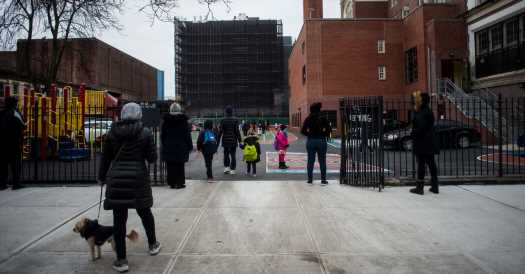C.D.C. officials say most available evidence indicates schools can be safe if precautions are taken on campus and in the community.

Open schools. Close indoor dining.
When to keep schools open, and how to do so, has been an issue plaguing the response by the United States to the pandemic since its beginning. President Biden vowed to “teach our children in safe schools” in his inaugural address.
On Tuesday, federal health officials weighed in with a call for returning children to the nation’s classrooms as soon as possible, saying the “preponderance of available evidence” indicates that in-person instruction can be carried out safely as long as mask-wearing and social distancing are maintained.
But local officials also must be willing to impose limits on other settings — like indoor dining, bars or poorly ventilated gyms — in order to keep infection rates low in the community at large, researchers at the Centers for Disease Control and Prevention wrote in the journal JAMA.
School administrators must limit risky activities such as indoor sports, they added. “It’s not going to be safe to have a pizza party with a group of students,” Margaret Honein, a member of the C.D.C.’s Covid-19 emergency response team and the first author of article, said in an interview. “But outdoor cross-country, where distance can be maintained, might be fine to continue.”
Federal officials cited the many benefits of in-person schooling for children, and argued for prioritizing their educational, developmental and emotional and mental health needs. “Schools are an important source not just of education, but health and social services for children,” Dr. Honein said.
Even though the pandemic is rapidly changing, and contagious new variants are spreading, Dr. Honein and other C.D.C. officials argued there is little evidence that schools spark the kind of outbreaks seen in nursing homes and meatpacking plants, or contribute to increased transmission in communities.
“Back in August and September, we did not have a lot of data on whether or not we would see the same sort of rapid spread in schools that we had seen in other high-density work sites or residential sites,” Dr. Honein said. “But there is accumulating data now that with high face mask compliance, and distancing and cohorting of students to minimize the total number of contacts, we can minimize the amount of transmission in schools.”
The call by Dr. Honein and other officials reflects a consensus among some leading educators and public health experts that schools should be the last to close and the first to open when shutdowns are necessary.
Last year, all kindergarten to grade 12 public schools closed for in-person instruction by March 25, shortly after the World Health Organization declared that the new coronavirus outbreak was a pandemic. Many schools subsequently switched to online teaching models for the rest of the school year.
During the fall term, about one-quarter of school districts were completely online, about half were using a hybrid model, and fewer than one-quarter were fully open for in-person teaching. Yet more than half of school districts had students participating in sports programs.
In an opinion column in USA Today earlier this week, Randi Weingarten, the president of the American Federation of Teachers, and Dr. Rajiv Shah, president of the Rockefeller Foundation, called for widespread testing to keep schools safe and get children back into the classroom, not only for educational reasons, but to restore free school meals, give children a social outlet, and provide myriad school-based services that are vital to low-income children.
The Covid-19 School Response Dashboard, a collaboration that tracks infections in school districts willing to share data, has reported that infection case rates among staff in October and November were similar to case rates in the surrounding communities. More recently, however, staff case rates in New York increased at a faster rate than community case rates.
The causes are not clear. The increases may reflect a more frequent testing of schoolteachers. Case rates increased among teachers engaged in in-person teaching and among those teaching remotely, suggesting in-person instruction was not the sole factor.
Emily Oster, a professor of economics and public policy at Brown University who created the dashboard, said that low case rates in the community make it possible to keep schools running safely.
“Prioritizing schools is going to mean limiting some of those other activities, and deciding that we want to undertake some of those sacrifices to keep schools open, because we’ve decided as a society that schools are important relative to other things,” Dr. Oster said.
“The frustration for many people is that you can go to an indoor restaurant. In Massachusetts, I could go to an indoor water park like Great Wolf Lodge — I can take my kids to Great Wolf Lodge. But in a lot of places in Massachusetts, there has been no school.”
The C.D.C. also published two related studies on Tuesday. One was an investigation of a high school wrestling tournament in Florida in December that became a super-spreader event, leading to at least 79 infections and one death.
The tournament brought together 10 schools and 130 athletes and coaches, and 30 percent of participants were infected with the coronavirus. Thirty-eight individuals went on to transmit the virus to at least 41 others, including family members. (The full number is not yet known, because fewer than half the participants were tested.)
The researchers calculated that 1,700 in-person school days were lost to quarantines and isolation of patients and their contacts. The number would have been higher if not for the December holiday break.
C.D.C. researchers also took a look at 17 elementary and secondary schools in rural Wisconsin where mask-wearing was routine. The incidence of infection was lower in schools than in the community at large, the scientists found. During 13 weeks in the fall of 2020, there were 191 infections among staff and students; only seven resulted from in-school transmission, according to the study.
Source: Read Full Article
